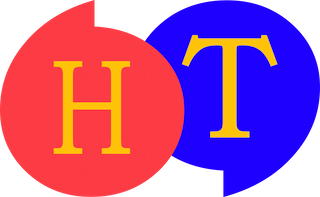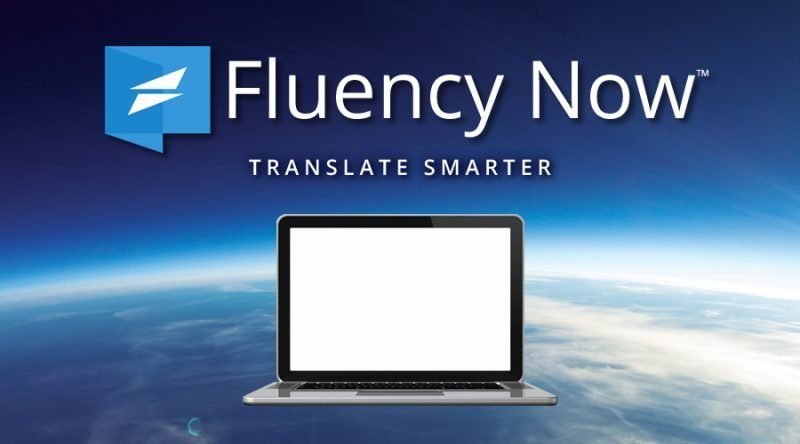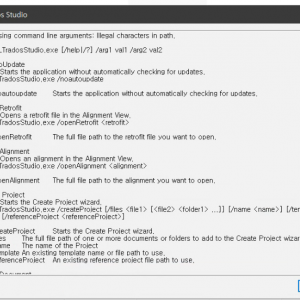Welcome to the “English Email Writing E-Course for Translators Who Are Non-Native English Speakers”!
This is a course designed for translators whose native language isn’t English but must communicate in English. A third of a translator’s work is communication. And 98% of that communication happens through email. If you use email to accurately and effectively communicate, you can prevent various problems that stem from misunderstanding, form a stable and long-term relationship with your clients, and ultimately improve your productivity as a translator.
This course consists of the following five lessons.
Lesson 1: The Excitement and Fear of Writing English Emails, Effective Email Communication Strategy
Lesson 2: Understanding the Cultural Differences of English Emails for Effective Communication
Lesson 3: 100 Basic Sentence Moulds for Every Purpose to Easily Compose English Sentences
Lesson 4: English Email Writing Practice
Lesson 5: Sample Emails for Every Situation
You can progress through the course at pace comfortable for you, there’s no need to try and finish the course in a hurry. For Lesson 3, lesson 4, and lesson 5, delegate a set time every day to the course and progress through them in a consistent manner. I also recommend reviewing these three courses once more after finishing the course to completely familiarize yourself with them.
Through this course, I hope you will be able to overcome your fear of emails and come to enjoy writing them!
Lesson 1: The Excitement and Fear of Writing English Emails, Effective Email Communication Strategy
“One language sets you in a corridor for life. Two languages open every door along the way.”
‒Frank Smith
Forewords
This lesson is an introductory lesson that will look at what kind of role English emails play and how big of a part it takes up in a translator’s life. Lesson 1 consists of the following contents.
- The importance of email communication to a translator
- The difficulty of using English email for foreign language translators
- Effective email usage strategy based on the advantages and disadvantages of email
1. The importance of email communication to a translator
According to statistics, translators spend 30% of their working time trying to find new work. I think this is because they weren’t able to properly settle into their place in the market or are leading their translation careers without a long-term strategy. But even if that time is decreased to 10%, most of that 10% will be time spent reading or writing emails.
Then, if you look at ordinary communication apart from trying to find work, the importance of emails increases even more. Email is the most effective and efficient method for a translator to meet and communicate through the Internet with a client in a different time zone. So while there aren’t any statistics about this, judging from my case and the cases of other translators I know, I can say that 98% of a translator’s communication happens through email. Therefore, on the whole, we can say that approximately 30% of a translator’s working hours is spent reading and writing emails. This is because everything from bidding to negotiating prices and deadlines, discussing the nature of projects, sending and receiving files, and resolving various issues that arise while working on a project all happens over email.
The reason email is used to this extent by translators is because of the unique advantages the email possesses.
- Because emails can be written when you want to write them and read when you want to read them, they won’t disrupt the translator’s work momentum and will save the most time.
- Emails are also the most effective and efficient method for PM’s who must contact or send files to multiple translators at once.
- Because the time zones are different for the client and translator, communication via phone, SNS, etc. are realistically difficult to do.
- Because their job deals with documents, translators have to send and receive files and the email is most appropriate means of communication to do that.
- Because email is a method of communication that gets recorded in text, you can always accurately review past communication and reuse it.
- Email itself becomes a record and proof of a translator’s work.
2. The difficulty of using English email for foreign language translators
Just as we looked at in the above section, the importance of email to a translator is indeed enormous. However, emailing in English in the Internet market is not such an easy task for translators who aren’t native English speakers. Being translators, they’re able to read and understand English better than anyone but writing an email in English might be quite burdensome. The reasons for that are as follows.
- Because our English education was focused on reading and listening rather than writing and speaking, we might feel a little helpless when actually trying to write something in English
- Even translators who have dealt with English for a long time are mostly used to English in the form of mass media, books, and magazines, and don’t have a lot of experience using email to communicate
- While writing is composed of sentence units, the overall structure and flow of writing is also very important and almost no education has been given regarding that part
- Because the mindset between English-speaking cultures is different from other cultures, there are also differences in the way emails should be written
3. Effective email usage strategy based on the advantages and disadvantages of email
Thinking about the importance and advantages of emails that we analyzed above as well as the difficulty we feel when reading and writing emails in English, in this section, I will be proposing a kind of road map to using emails effectively in the future. The tips suggested below are mostly basic things that you have to abide by whether your email is in English or any other language.
A. Cherish your email account, manage it, and protect it.
What’s more important than how to write an email is how you manage your email account. First of all, unsubscribe to any unwanted mail. There are often cases when you continue to receive emails from a place you no longer need or want to hear from because you subscribed to it at one time. When that happens, you must unsubscribe from them even though it might be tedious to do. That is the first step toward filling your inbox with only the things you need.
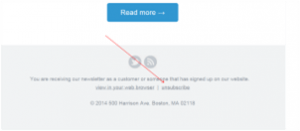
As you can see above, there is usually an unsubscribe link at the bottom of those kinds of emails that you can click to stop receiving the mail. In this way, you must manage your account so that your email inbox doesn’t fill up with useless mail. However, before taking this kind of action, you must first be very careful about subscribing in the first place. Also, there are many cases where you end up subscribing to something without even knowing. For example, when you download a piece of software from somewhere, a lot of the times, the box saying you wish to receive newsletter from that site is automatically checked. They want to get your email to legally spam you with their advertisements. Boldly un-check such boxes. You can live well without such a thing. In today’s age of excess information, it’s rare that you’ll suffer a loss from lack of information. Rather, wasting your time being swept up by the flood of information, not being able to recognize the truly necessary and valuable information, and not being able to properly focus on that kind of information is the true loss.
Another important thing is reporting spam every time you find spam in your inbox. People who spread spam around on the Internet are always such a nuisance. I’ve seen many people give up their precious email addresses to make a new one because they don’t know how to deal with these things, but that is really a big loss and it also inconveniences the good-willed people who try to contact you through that email address. When you see spam, report the spam. It’s very simple. All you have to do is click the spam icon when you have that spam mail open.
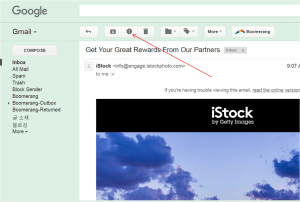
If you report it once, it will automatically get sent to your spam box the next time it comes. Sometimes, when you click the spam icon, Gmail kindly asks if you’d like to unsubscribe from emails sent from this site and does that work for you. You can get unsubscribed in this way in the cases of legal sites that you’ve inadvertently been subscribed to.
There are many other good features in Gmail in addition to the one I described above. While you don’t need to know all of them, take a look around to find and use the ones that’ll benefit you.
B. Use Gmail with dual security
Email is no longer simply a means to send and receive trivial messages with your friends but a core communication method through which you send and receive confidential business documents. Therefore, it is essential to keep your email account well maintained. It not only protects your business but your clients as well, and because your clients’ confidential affairs are being put in your hands, you must take the security of your email account seriously and follow through with the necessary procedures in a serious manner. If you use Gmail, I strongly recommend you set up dual security. It uses Google’s security technology for free.
You can do this for your Gmail account or any Google Apps account.
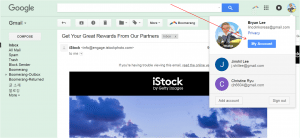
Click on the account indicated by the red arrow above. Then the following screen will show up.
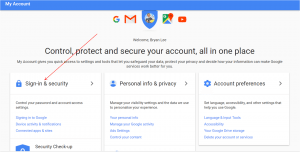
Then click on the Sign-in & security shown by the red arrow, and then choose the two-step authentication.
C. Communicate professionally.
- If possible, don’t talk about personal things with your clients. Save those kinds of stories for friends and family.
- Always maintain a courteous and professional tone and attitude.
- Don’t write emails when you’re angry, instead, wait until you’ve cooled down and write your email in an objective and calm state. Abiding by this principle can prevent a lot of problems. Even when you’re ending a relationship with a client, it’s a hundred times wiser to do it under sober judgment than when you’re angry.
D. Try your best to communicate clearly.
- Write your email title as clearly as possible. “Hello, How are you doing?” Writing this kind of thing is a waste of time for both parties. Clearly state your business in the subject line.
- Start with the conclusion in the body of your email. And then, if necessary, add in reasons or examples. This is the way of Western communication and writings (this is covered in more detail in lesson 2).
- When you have a lot of complex things to say, it’s a good idea to clearly divide each item by numbering them. Wouldn’t you be annoyed if you send someone a long email and that person only replies to two or three things you mentioned and leaves the rest unanswered? You’d have to pick out the unanswered bits and write another email about it and an entire day or two will pass by unproductively. So, make sure your client can’t help but answer each item by numbering every item. If your client answers only a part of your email even though you wrote your email this way, that’s not your fault and your client either doesn’t want to answer or has a serious communication disability.
E. Use email auto signatures.
Because you have to write a large number of emails a day, it’s quite convenient to register an automatic signature. Because you don’t have to repetitively write the same thing dozens of times a day. (My signature is “Yours, Bryan”.)
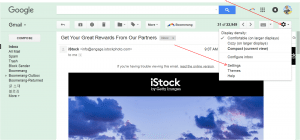
If you click on the icon that looks like a gear located in the upper right of the screen, a drop-down menu will appear like the one you see in the image. From there, click on Settings.

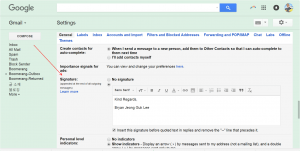
If you scroll down to the bottom of the screen, you will see the “signature” that the red arrow is pointing at. I chose a simple signature like that and made the selection to have that signature appear in replies as well. It’s not much but if you just set this up once, you will no longer have to type a signature in the dozens of emails you write a day and will be able to just send your emails once you write the content.
F. Send out-of-office notifications.
This is a function that automatically sends a notification that you’re out of office when someone sends you an email when you’re not working. If you do this, those sending you urgent emails will be able to send urgent work to someone else since they’ll receive this automatic response from you as soon as they send you the email. Of course, it’s not as if you can’t receive emails at all on vacation so you can reply to urgent email yourself if you wish. The vacation notification function still plays a good role in those kinds of cases as well. The client might be moved that you kindly sent them a response even while on vacation. Of course, they’ll understand even if you don’t send a reply.
If you scroll down a little more from the above screen before, there is a part like the one shown below.
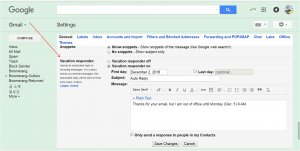
As you can see on the above screen, you can select “turn on out-of-office auto response” and enter the starting date and end date. This allows you to set it up even a few weeks prior to your vacation since you can enter the dates this way. Then, all you have to do is write a simple message like the one the second red arrow is pointing at. Since you’ve set up an auto signature above, as you can see here, all you have to do here is write the body. There’s no reason to only use this function once or twice a year when you go on a long, far away vacation. If you can’t or don’t want to respond to emails due to personal reasons, you can use this function anytime even when not on vacation. You also can use this when you want to go away somewhere for a couple of days.
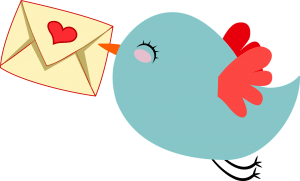
This concludes Lesson 1. Good work and congratulations!
